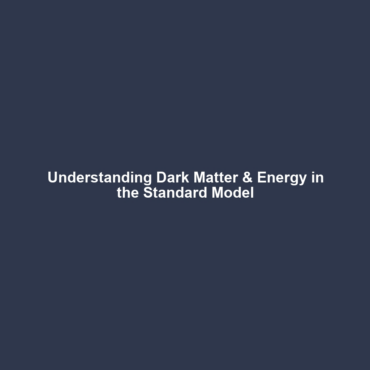Standard Model of Cosmology: Where Do Dark Matter and Dark Energy Fit?
The Standard Model of Cosmology serves as an essential framework for understanding the universe and its evolution. Within this model, dark matter and dark energy play crucial roles, influencing cosmic structure and expansion. By delving into the significance of these elements, we can enhance our grasp of the cosmos and the forces that shape it. This article explores the intricate relationships between the Standard Model of Cosmology, dark matter, and dark energy, shedding light on their relevance and implications.
Key Concepts
The standard model of cosmology, also known as the ΛCDM model, incorporates several fundamental concepts:
- Dark Matter: This mysterious substance makes up about 27% of the universe’s total mass-energy content, exerting gravitational effects that influence cosmic structures without emitting light.
- Dark Energy: Comprising about 68% of the universe, dark energy is responsible for the observed acceleration in cosmic expansion.
- Cosmic Microwave Background (CMB): The remnant radiation from the Big Bang, providing a snapshot of the early universe and strong evidence supporting the Standard Model.
Applications and Real-World Uses
The Standard Model of Cosmology provides the foundation for various practical applications and studies in dark matter and dark energy:
- How the Standard Model of Cosmology is used in astrophysics: Researchers utilize the model to analyze cosmic structures and the evolution of galaxies.
- Applications of cosmological simulations: These simulations help predict cosmic behavior and guide observations, enhancing our understanding of dark matter’s gravitational influence.
- Instrumentation advancements: Technology developed for detecting dark energy and dark matter effects leads to innovations in other scientific fields, such as material sciences.
Current Challenges
Despite its successes, the study of the Standard Model of Cosmology presents numerous challenges:
- Challenges of measuring dark matter: The elusive nature of dark matter particles complicates direct detection efforts.
- Issues in understanding dark energy: The origins and properties of dark energy remain enigmatic, hindering advancements in theoretical frameworks.
- Data interpretation: Disentangling the effects of dark matter and dark energy from observational data can lead to misinterpretations and inaccuracies.
Future Research and Innovations
Future research in the Standard Model of Cosmology promises exciting innovations:
- Breakthroughs in particle physics: Upcoming experiments may lead to the identification of dark matter particles, enhancing our understanding of cosmic composition.
- Next-gen telescopes: Future observational tools, such as the James Webb Space Telescope, will provide unprecedented insights into dark energy and its role in cosmic expansion.
- Innovative theoretical models: Emerging models may redefine our approach to understanding the dynamics of dark matter and dark energy interactions.
Conclusion
The integration of dark matter and dark energy within the Standard Model of Cosmology is fundamental to comprehending the universe’s structure and expansion. As research advances, we will uncover deeper insights that could revolutionize our understanding of cosmic phenomena. To stay informed about ongoing developments in dark matter and dark energy research, consider following our updates on related topics, including future research and key concepts.
